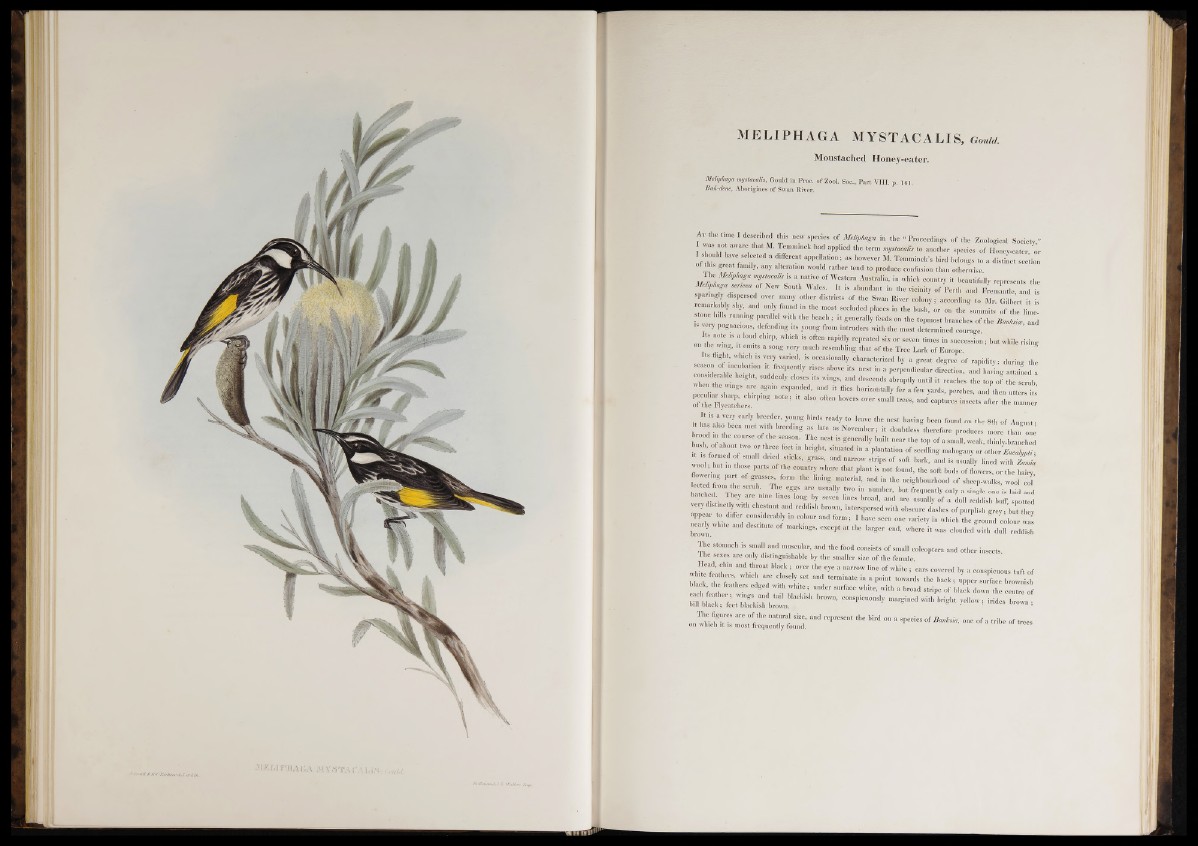
MELIPHAGA MYSTACALIS, Gould.
Moustached Honey-eater.
Meliphaga mystacalis, Gould in Proc. of Zool. 8oc., Part VIII. p. 161.
Ban-dene, Aborigines of Swan River.
At the time I described this new species o f Meliphaga in the:-Proceedings of the Zoological Society'
r I" H aWare, M' Temmmck had aPPIied the term mystacalista another species o f Honey-eater Ó.
I should have selected a different appellation M however M. Temminck's bird belongs to a distinct section
ot this great family, any alteration would rather tend to produce confusion than otherwise
The m — m m m B B S Australia, in which country it beautifully represents the
Mehphaga ser,cea o f New South Wales. It is abundant in the vicinity o f Perth and Fremantle and is
sparingly dispersed over many other districts of the Swan River colony ; according ,0 Mr. Gilbert it is
remarkably shy, and only found in the most secluded places in,the the 'summits o f the lime- ■ H H Imth ^ ! * Se”era“7 feeds 0" the B i o f the HÜ8 and
very pugnacious, defending its young from intruders with the most determined courage
— “ l0Udf Ch!rp' ™Pid>y r e P e a te d s i , or seven times in succession; bn, while rising
on the wing, it emits a song very much resembling that of tbe Tree Lark o f Europe
Its flight, which is very varied, is occasionally characterised by a great degree of rapidity: during the
season of incubation » frequently rises above its nest in a perpendicular direction, and having attained a
considerable height, suddenly closes its wings, and descends abruptly until it reaches the top o f the scrub
when the wings are again expanded, and it flies horizontally for a few yards, perches, and then utters its
of ,irF Iy ^ c ¿ e r s .lrP1Ug ^ °fte" b°VerS °Ver ^ *reeS’ “ d Cap‘UreS ¡"SeCte ^ T
I t is a very early breeder, young birds ready to leave the nes, having been found on the 8th o f August •
brood H I me‘ U H i ^ Iate 38 H i I B H i i Produces IMHMi brood ,u the course o f the season. The nest is generally built near the top of a small, weak, thiuly-hranched
bush of about two or three feet in height, situated in a plantation o f seedling mahogany or W
H hi,”t i f ^ o d sticksi grass and narrow strips o f soft bark, and is usually lined with z i n L
wool, but ,n those parts of the country where that plant is not found, the soft buds o f flowers, or the hairy
owenng part of grasses, form the lining material, and in the neighbourhood o f sheep-walks, wodl ¿ol’ BRH I T 1 US"aUy 1 !n DUmber' bU‘ a ^ 1 laid aad feT y d tin c d vw ith eh” ,6 H H ■ 8 B and arC H °f a du" very distncfly with chestnu and reddish brown, interspersed with obscure dashes o f pu rrpeldisdhi8 ghr e^y; b supto tthteedy
nearly""white d S H H R ■ H f f l 1M ■ ° ”e H 1 w^cb th/g rou fd cdour wZ
nearly white and destitute o f markings, except at the larger end, where it was clouded with dull reddish
The stomach is small and muscular, and the food consists o f small coleóptera and other insects.
8— 1 he sexes are only distinguishable by the Head chin and KhlCb throat are black BB ; over the a”d eye termi,,smaller size o f the female.
a narrow ate | line a o f white ; ears I covered by a Conspicuous tuft of P°in* “ wards ha'* ; upper surface brownish
ck the feathers edged with white; under surface white, with a broad stripe of black down the centre of
br0WD' S,y marS * ed with bright yellow; irides brown; o„ wLfihg:;i; BBSSand represeDt the bird on a species °f °ae °f a *ba